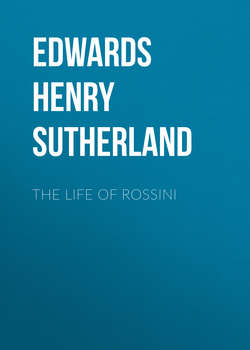The Life of Rossini

Реклама. ООО «ЛитРес», ИНН: 7719571260.
Оглавление
Edwards Henry Sutherland. The Life of Rossini
INTRODUCTION
PART I. ROSSINI AND HIS EARLY WORKS
CHAPTER I. ROSSINI’S YOUTH
CHAPTER II. ITALIAN OPERA UNTIL “TANCREDI.”
CHAPTER III. FOUR HISTORICAL OPERAS
CHAPTER IV. MOZART AND ROSSINI
CHAPTER V. ROSSINI’S REFORMS IN SERIOUS OPERA
CHAPTER VI. ROSSINI’S REFORMS IN COMIC OPERA
CHAPTER VII. ROSSINI’S REFORMS IN WRITING FOR THE VOICE
CHAPTER VIII. FROM MILAN TO NAPLES
PART II. ROSSINI AT NAPLES
CHAPTER I. ROSSINI, BARBAJA, AND MDLLE. COLBRAN
CHAPTER II. ELISABETTA – ROSSINI’S DÉBUT AT NAPLES
CHAPTER III. ROSSINI VISITS ROME – TORVALDO E DORLISKA
CHAPTER IV. BEAUMARCHAIS, PAISIELLO, AND ROSSINI
CHAPTER V “THE BARBER OF SEVILLE.”
CHAPTER VI “THE BARBER OF SEVILLE.” – FIRST REPRESENTATION
CHAPTER VII. OTELLO: FURTHER REFORMS IN OPERA SERIA
CHAPTER VIII. ROSSINI’S REPRODUCTIONS FROM HIMSELF
CHAPTER IX “LA GAZZA LADRA”: THE CONTRALTO VOICE
CHAPTER X. ARMIDA, ADELAIDA, AND ADINA
CHAPTER XI “MOSÈ IN EGITTO:” REFORMS IN OPERA SERIA
CHAPTER XII. THREE UNFAMILIAR WORKS
CHAPTER XIII. SACRED AND SECULAR SUBJECTS
CHAPTER XIV “LA DONNA DEL LAGO.”
CHAPTER XV. END OF ROSSINI’S ITALIAN CAREER
PART III. ROSSINI’S FRENCH CAREER
CHAPTER I. A VISIT TO LONDON – ROSSINI AND GEORGE IV
CHAPTER II. ROSSINI’S OPERA FOR THE KING’S THEATRE
CHAPTER III. ROSSINI IN PARIS
CHAPTER IV. ROSSINI AND HIS CRITICS
CHAPTER V. ROSSINI AT THE ITALIAN OPERA OF PARIS
CHAPTER VI. ROSSINI AT THE ACADÉMIE
CHAPTER VII “GUILLAUME TELL.”
CHAPTER VIII. ROSSINI AFTER “WILLIAM TELL.”
CHAPTER IX. THE “STABAT MATER.”
Отрывок из книги
ALTHOUGH Rossini’s artistic life did not number precisely the “three score and ten years” allotted to man, we must go back a full seventy years from the date of his last work to the first incident in his musical career. When, in 1799, Paer’s “Camilla,” written a few years before for Vienna, was brought out at Bologna, Rossini, then little more than an infant, took the part of the child. “Nothing,” says Madame Giorgi-Righetti,1 the original Rosina in the future composer’s “Barber of Seville,” “could be imagined more tender, more touching than the voice and action of this extraordinary child in the beautiful canon of the third act, ‘Senti in si fiero istante.’ The Bolognese of that time declared that he would some day be one of the greatest musicians known. I need not say whether the prophecy has been verified.”
Gioachino Antonio Rossini, born on the 29th of February, 1792, two months after the death of Mozart, was only seven years of age when he sustained a part in the work of a composer whose fame he was destined before long to eclipse. The child came of musical parentage, for his father held the office of trumpeter to the town of Pesaro, in the Romagna; while his mother, who possessed a very beautiful voice, was able, when the father fell into trouble, to support the family by singing on the stage.
.....
It was at that time the custom in Italy for the composer of a new opera to preside at its representation three successive times; but Rossini seemed determined to escape at least one of these trial performances.
However, he intended the overture as a sort of peace-offering. It was begun in his absence under the leadership of the first violin; and the first allegro was so much applauded that Rossini at once felt justified in leaving his hiding place by the entrance to the orchestra and taking his seat on the conductor’s chair. The crescendo, a means not invented by Rossini, but employed by him more persistently and with more success, than by any other composer, produced an effect which was repeated again and again in subsequent works, and never once too often. In fact, the whole of the animated and rather joyous prelude to what, if not a very serious opera, is at least an opera on a very serious subject, was received with expressions of delight.
.....